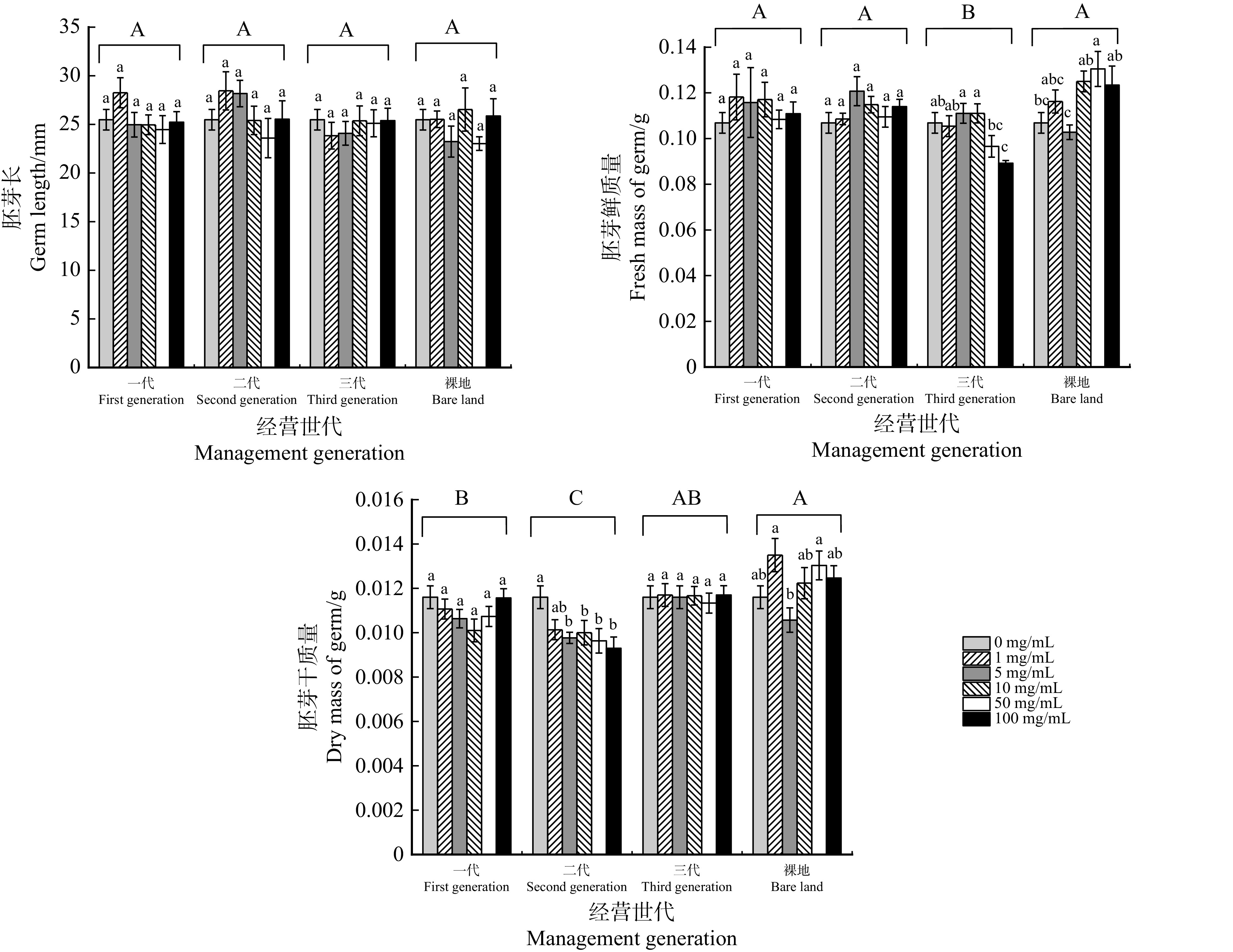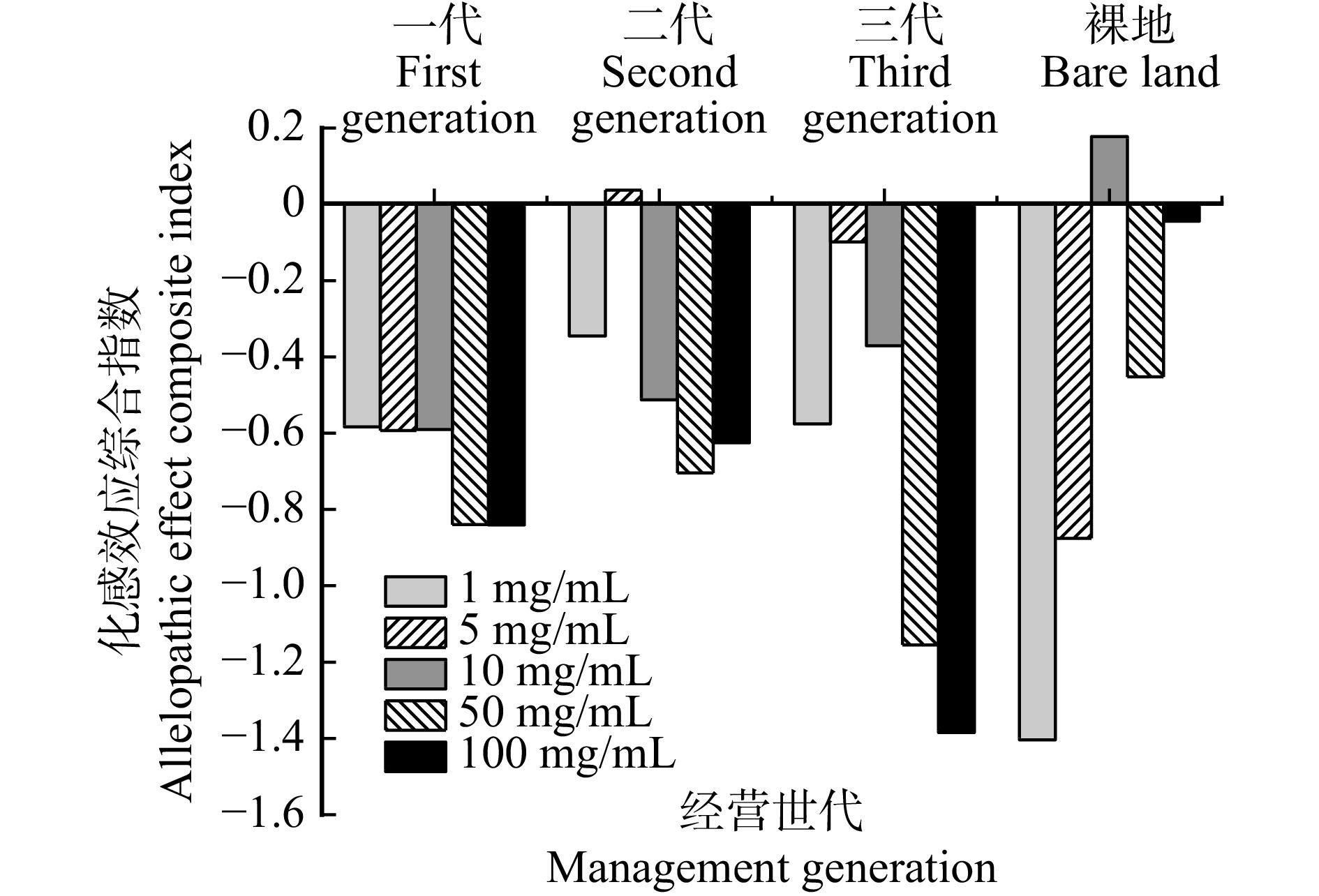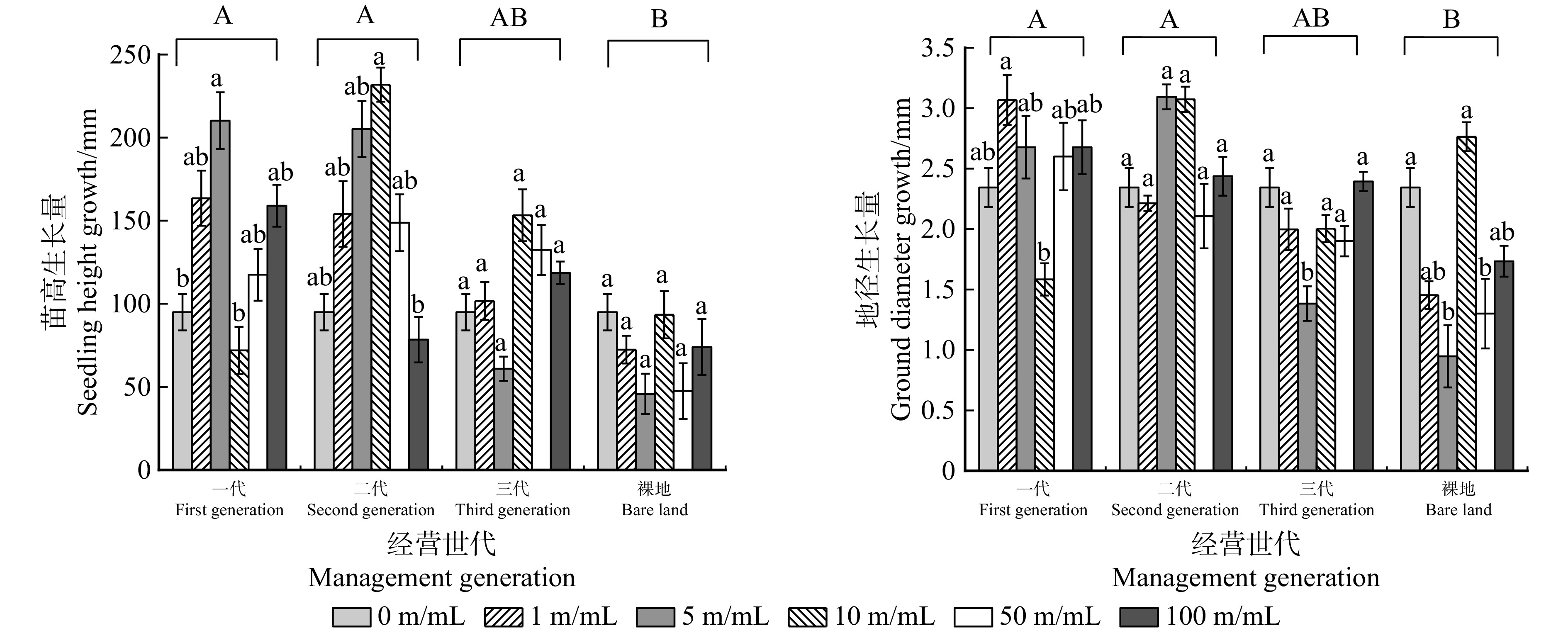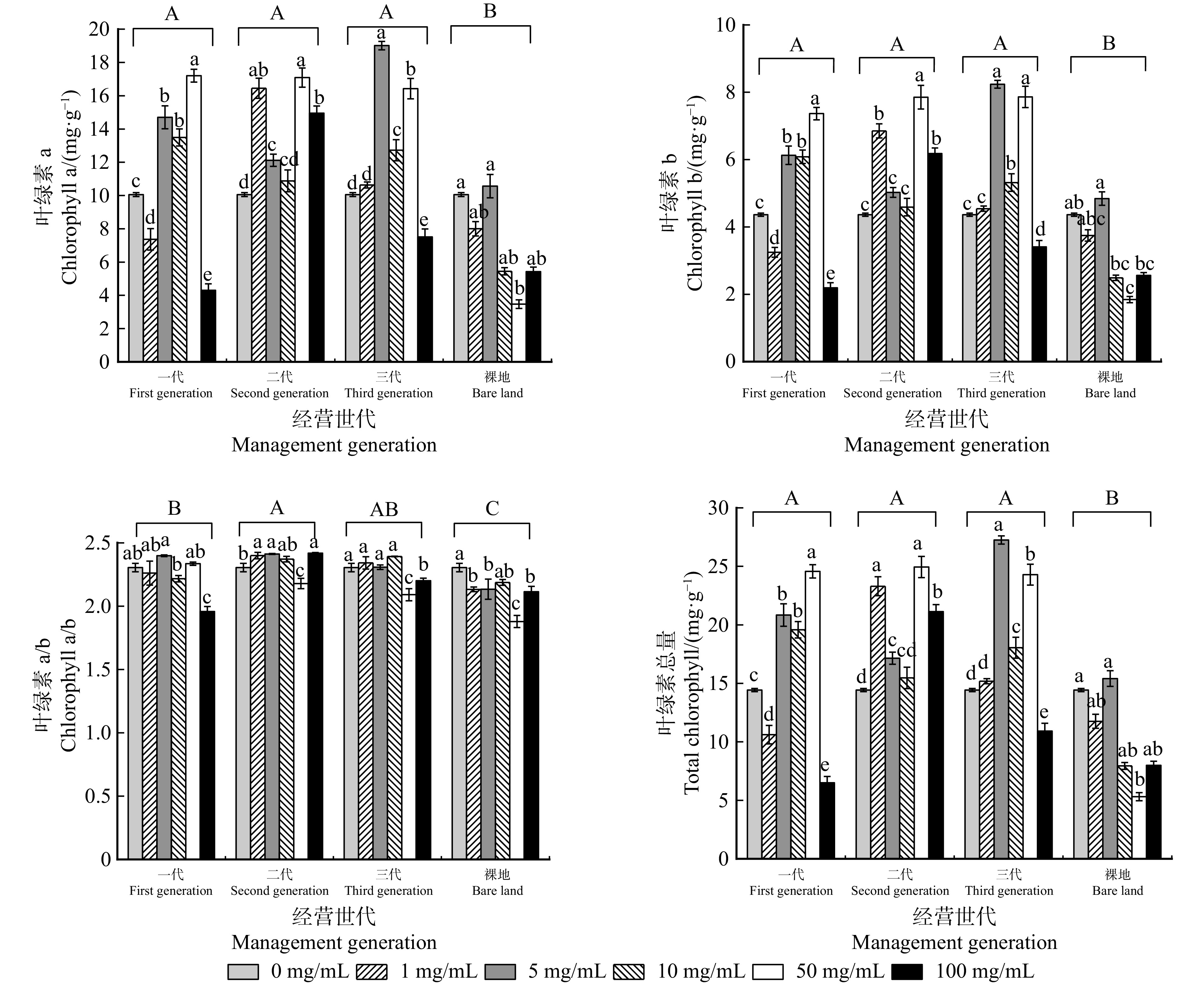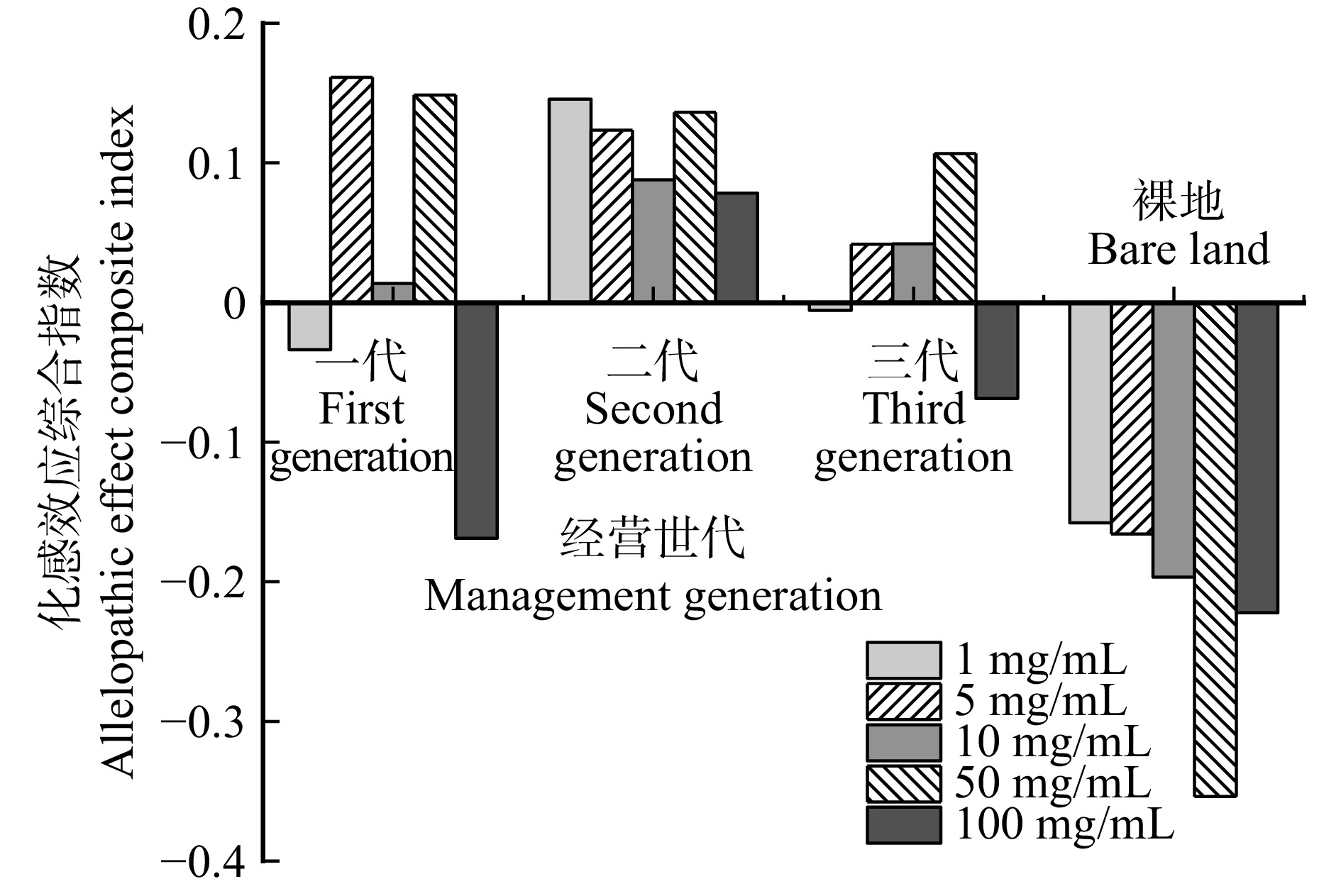Effects of extracts from rhizosphere soil of Robinia pseudoacacia of different management generations on seed germination and seedling growth
-
摘要:目的
探究豫西浅山丘陵区不同经营世代刺槐和不同质量浓度根际土浸提液对刺槐种子萌发和幼苗生长发育过程的影响,揭示刺槐多代经营培养下根系分泌物对刺槐更新的化感效应,为刺槐破解连栽障碍和实现可持续经营提供理论依据。
方法选取刺槐不同经营世代林(一代、二代、三代林)为研究对象,以裸地为对照,各设置3块样地进行基本林分调查,分别制备1、5、10、50、100 mg/mL不同质量浓度刺槐根际土浸提液,进行刺槐种子萌发和幼苗生长试验,并测定种子萌发和幼苗生长等相应指标。
结果刺槐根际土浸提液会对刺槐种子萌发产生一定影响,根据化感综合效应指数来看,在一代林中,随着根际土浸提液质量浓度的增加,对刺槐种子萌发的抑制作用逐渐增强;在二代、三代林中,仅在二代林5 mg/mL时表现出促进作用,其余质量浓度均表现为抑制作用;在三代林中,随着根际土浸提液质量浓度的增加,对刺槐种子萌发的抑制作用均表现为先减弱后增强的趋势。刺槐根际土浸提液会对刺槐幼苗生长产生一定影响,根据化感综合效应指数来看,在一代林与三代林中,均随着浸提液质量浓度的增加,对刺槐幼苗生长由抑制作用转为促进作用再转为抑制作用,一代林和三代林在100 mg/mL时均为抑制作用,且抑制作用最强;在二代林中,不同质量浓度刺槐根际土浸提液对刺槐幼苗生长均为促进作用;裸地中,随着浸提液质量浓度的增加,对刺槐幼苗生长的抑制作用先增强后减弱,在50 mg/mL时达到最大值。
结论多代经营的刺槐林根系分泌物会在一定程度上抑制刺槐种子萌发,但对于种子萌发以后的幼苗生长阶段并不存在抑制作用,甚至有利于其生长。
Abstract:ObjectiveThis paper explores the effects of different management generations of Robinia pseudoacacia and varied concentrations of rhizosphere soil extracts on the germination of R. pseudoacacia seeds and the growth and development of seedlings in the shallow mountains and hilly areas of western Henan Province of northern China, reveals the allelopathic effects of root exudates on R. pseudoacacia regeneration under multi generation management and cultivation so as to provide a theoretical basis for R. pseudoacacia to overcome continuous planting obstacles and achieve sustainable management.
MethodThis study selected different generations of R. pseudoacacia forests (first generation, second generation, and third generation forests) as the research object, using bare land as the control, set up three sample plots for basic stand investigation, preparing 1, 5, 10, 50, and 100 mg/mL of R. pseudoacacia rhizosphere soil extracts with different mass concentrations, conducting R. pseudoacacia seed germination and seedling growth experiments, and measuring corresponding indicators such as seed germination and seedling growth.
ResultThe extract of R. pseudoacacia rhizosphere soil had a certain impact on the germination of R. pseudoacacia seeds. According to the allelopathic comprehensive effect index, in the first generation forest, the inhibitory effect on germination of R. pseudoacacia seeds gradually increased with the increase of concentration of rhizosphere soil extract in different management generations. In the second and third generation forests, only a promoting effect was observed at 5 mg/mL in the second generation forest. The remaining mass concentrations exhibited inhibitory effects. In the third generation forest, as the concentration of rhizosphere soil extract increased, the inhibitory effect on the germination of R. pseudoacacia seeds showed a trend of first weakening and then strengthening. The extract of R. pseudoacacia rhizosphere soil had a certain impact on the growth of seedlings of R. pseudoacacia. According to the comprehensive effect index of allelopathy, in both the first and third generations of forests, the growth of Robinia pseudoacacia seedlings changed from inhibitory effect to promoting effect and then to inhibitory effect with the increase of leaching solution concentration. Both the first and third generations of forests had inhibitory effect at 100 mg/mL, and the inhibitory effect was the strongest. In second-generation forests, different concentrations of Robinia pseudoacacia rhizosphere soil extracts had a promoting effect on the growth of Robinia pseudoacacia seedlings; In bare soil, as the concentration of extract increased, the inhibitory effect on the growth of Robinia pseudoacacia seedlings first increased and then decreased, reaching its maximum value at 50 mg/mL.
ConclusionThe root exudates of multiple generations of R. pseudoacacia forests will to some extent inhibit the germination of R. pseudoacacia seeds, but there is no inhibitory effect on the seedling growth stage after seed germination, and it may even be beneficial for its growth.
-
Keywords:
- Robinia pseudoacacia /
- rhizosphere soil /
- seed germination /
- seedling growth /
- allelopathic effect
-
-
图 1 不同根际土浸提液处理对刺槐种子发芽的影响
不同小写字母表示同种经营世代不同质量浓度间差异显著(P < 0.05);不同大写字母表示不同经营世代间差异显著(P < 0.05)。下同。Different lowercase letters indicate significant differences between varied mass concentrations in the same generation (P < 0.05). Different capital letters indicate significant differences between varied management generations (P < 0.05). The same below.
Figure 1. Effects of different rhizosphere soil extracts on germination of Robinia pseudoacacia seeds
表 1 样地林分基本信息
Table 1 Basic information of forest stands in sample plots
林分类型
Stand type地理坐标
Geographical coordinate林龄/a
Forest
age/year平均海拔
Average
altitude/m平均坡度
Average
gradient/(°)平均胸径
Mean
DBH/cm平均树高
Mean tree
height/m平均活枝下高
Average height
under living branch/m平均郁闭度
Average canopy
density一代林
First generation forest34°28′00″N,111°29′48″E 15 665.00 18.33 9.71 10.11 5.59 0.47 二代林
Second generation forest34°27′53″N,111°29′58″E 15 645.67 13.67 10.02 9.86 4.51 0.37 三代林
Third generation forest34°26′02″N,111°29′18″E 16 677.00 22.33 7.25 8.61 4.65 0.53 裸地
Bare land34°26′35″N,111°29′56″E 649.23 10.22 -
[1] 孙长忠, 沈国舫. 对我国人工林生产力评价与提高问题的几点认识[J]. 世界林业研究, 2001, 14(1): 76−80. doi: 10.3969/j.issn.1001-4241.2001.01.012 Sun C Z, Shen G F. Some opinions on the evaluation and improvement of plantation productivity in China[J]. World Forestry Research, 2001, 14(1): 76−80. doi: 10.3969/j.issn.1001-4241.2001.01.012
[2] 茹桃勤, 李吉跃, 张克勇, 等. 国外刺槐(Robinia pseudoacacia)研究[J]. 西北林学院学报, 2005, 20(3): 102−107. doi: 10.3969/j.issn.1001-7461.2005.03.027 Ru T Q, Li J Y, Zhang K Y, et al. Review on research of Black Locust (Robinia pseudoacacia) in abroad[J]. Journal of Northwest Forestry University, 2005, 20(3): 102−107. doi: 10.3969/j.issn.1001-7461.2005.03.027
[3] 伍征明. 刺槐的经济价值与造林技术[J]. 湖南林业科技, 2002, 29(1): 79−80. doi: 10.3969/j.issn.1003-5710.2002.01.028 Wu Z M. The economic value and afforestation techniques of Robinia pseudoacacia[J]. Hunan Forestry Science & Technology, 2002, 29(1): 79−80. doi: 10.3969/j.issn.1003-5710.2002.01.028
[4] 丁鹏. 刺槐的利用价值与嫁接技术[J]. 现代农业科技, 2015, 50(19): 173−177. doi: 10.3969/j.issn.1007-5739.2015.19.103 Ding P. Utilization value and grafting technology of locust[J]. Xiandai Nongye Keji, 2015, 50(19): 173−177. doi: 10.3969/j.issn.1007-5739.2015.19.103
[5] 高洪真, 毕君. 刺槐蜜源林培育技术研究[J]. 东北林业大学学报, 1998, 26(4): 29−32. Gao H Z, Bi J. The cultivation technique of black locust nectariferous forest[J]. Journal of Northeast Forestry University, 1998, 26(4): 29−32.
[6] 王秀芳. 刺槐四倍体饲料型无性系区域化试验初步研究[D]. 北京: 北京林业大学, 2003. Wang X F. The preliminary research of tetraploid fodder clones of Robinia pseudoacacia in regional trial[D]. Beijing: Beijing Forestry University, 2003.
[7] 商立志. 刺槐薪炭林营造及管理[J]. 河北林业科技, 2009, 37(4): 129. doi: 10.3969/j.issn.1002-3356.2009.04.079 Shang L Z. Plantation and management of Robinia pseudoacacia fuel forest[J]. The Journal of Hebei Forestry Science and Technology, 2009, 37(4): 129. doi: 10.3969/j.issn.1002-3356.2009.04.079
[8] 陈一鹗, 刘康, 李文华. 皆伐萌蘖更新是改造刺槐林的有效途径[J]. 水土保持通报, 1995, 15(6): 64−68. Chen Y E, Liu K, Li W H. Clear-cutting and root-sprout regeneration is an efficient way for large-scale refoeming of locust forest[J]. Bulletion of Soil and Water Conservation, 1995, 15(6): 64−68.
[9] 耿兵, 王华田, 王延平, 等. 刺槐萌生林与实生林的生长比较[J]. 中国水土保持科学, 2013, 11(2): 59−64. doi: 10.3969/j.issn.1672-3007.2013.02.010 Geng B, Wang H T, Wang Y P, et al. Comparative study of coppice and seeding forest of Robinia pseudoacacia L.[J]. Science of Soil and Water Conservation, 2013, 11(2): 59−64. doi: 10.3969/j.issn.1672-3007.2013.02.010
[10] 张长庆, 张文辉. 黄土高原不同立地条件下刺槐人工林种群的无性繁殖与更新[J]. 西北农林科技大学学报(自然科学版), 2009, 37(1): 135−144. Zhang C Q, Zhang W H. A study on asexual reproduction and regeneration of Robinia pseudoacacia plantations in different habitats in hilly area of the Loess Plateau[J]. Journal of Northwest A& F University, 2009, 37(1): 135−144.
[11] 王雅慧, 彭祚登, 李云. 豫西浅山区不同世代刺槐林土壤生物学特性[J]. 中南林业科技大学学报, 2021, 41(3): 140−148. Wang Y H, Peng Z D, Li Y. Soil biological characteristics of different generations of Robinia pseudoacacia forests in western Henan[J]. Journal of Central South University of Forestry & Technology, 2021, 41(3): 140−148.
[12] 王雅慧, 彭祚登, 李云. 豫西浅山区不同世代刺槐林土壤养分与结构特征[J]. 北京林业大学学报, 2020, 42(3): 54−64. doi: 10.12171/j.1000-1522.20190263 Wang Y H, Peng Z D, Li Y. Soil nutrient and structure characteristics of Robinia pseudoacacia in different nerations in the shallow mountain areas of western Henan Province, central China[J]. Journal of Beijing Forestry University, 2020, 42(3): 54−64. doi: 10.12171/j.1000-1522.20190263
[13] 马艳丽. 化感作用在林业中的研究现状[J]. 林业科技, 2012, 37(6): 48−52. doi: 10.3969/j.issn.1001-9499.2012.06.018 Ma Y L. Research status of allelopathy in forestry[J]. Forestry Science & Technology, 2012, 37(6): 48−52. doi: 10.3969/j.issn.1001-9499.2012.06.018
[14] 崔磊, 赵秀海, 张春雨. 化感作用研究动态及展望[J]. 浙江林业科技, 2006, 26(1): 65−70. doi: 10.3969/j.issn.1001-3776.2006.01.018 Cui L, Zhao X H, Zhang C Y. Research trends and prospects of allelopathy[J]. Journal of Zhejiang Forestry Science and Technology, 2006, 26(1): 65−70. doi: 10.3969/j.issn.1001-3776.2006.01.018
[15] 马祥庆, 刘爱琴, 黄宝龙. 杉木人工林自毒作用研究[J]. 南京林业大学学报, 2000, 24(1): 15−19. Ma X Q, Liu A Q, Huang B L. A study on self-poisoning effects of Chinese fir plantation[J]. Journal of Nanjing Forestry University, 2000, 24(1): 15−19.
[16] 朱美秋, 刘春鹏, 邓明静, 等. 臭椿根系水浸提液的化感效应[J]. 森林与环境学报, 2015, 35(3): 284−288. Zhu M Q, Liu C P, Deng M J, et al. Allelopathy of aqueous extracts obtained from roots of Ailanthus altissima[J]. Journal of Forest and Environment, 2015, 35(3): 284−288.
[17] 王仙, 魏天兴, 朱金兆, 等. 黄土丘陵区油松根系化感效应研究[J]. 北京林业大学学报, 2015, 37(4): 82−89. Wang X, Wei T X, Zhu J Z, et al. Allelopathic effect of Pinus tabuliformis root in loess hilly area[J]. Journal of Beijing Forestry University, 2015, 37(4): 82−89.
[18] 赵源, 邓蓉, 黄钧. 半夏连作障碍成因及防治研究进展[J]. 应用与环境生物学报, 2022, 28(4): 1102−1108. Zhao Y, Deng R, Huang J. Research advances on causes and prevention for the continuous cropping obstacle of Pinellia ternata[J]. Journal of Applied and Environmental Biology, 2022, 28(4): 1102−1108.
[19] 刘雨艳, 保丽美, 魏云林, 等. 连作三七根际土壤自毒物质与微生物互作研究进展[J]. 中药材, 2022, 45(1): 242−247. Liu Y Y, Bao L M, Wei Y L, et al. Research progress on the interaction between self toxic substances and microorganisms in the rhizosphere soil of continuous cropping Panax notoginseng[J]. Journal of Chinese Medicinal Materials, 2022, 45(1): 242−247.
[20] 李轲, 杨柳. 刺槐根际土壤水浸提液对5种常见园林植物种子萌发及幼苗生长的化感作用[J]. 种子, 2019, 38(6): 115−120. Li K, Yang L. Allelopathic effects of aqueous extracts from rhizosphere soil of Robinia pseudoacacia Linn on seed germination and seeding growth of five kinds of common garden plants[J]. Seed, 2019, 38(6): 115−120.
[21] 何斐, 崔鸣, 孙娅, 等. 刺槐凋落叶腐解液对3种作物的化感效应[J]. 西北林学院学报, 2021, 36(2): 116−122. doi: 10.3969/j.issn.1001-7461.2021.02.17 He F, Cui M, Sun Y, et al. Allelopathic effects of decomposed liquid of Robinia pseudoacacia leaf litter on three crops[J]. Journal of Northwest Forestry University, 2021, 36(2): 116−122. doi: 10.3969/j.issn.1001-7461.2021.02.17
[22] 荆蓉, 彭祚登, 李云, 等. 刺槐林腐殖质浸提液对自身种子萌发和幼苗生长的影响[J]. 西北农林科技大学学报(自然科学版), 2023, 51(7): 1−15. Jing R, Peng Z D, Li Y, et al. Effects of humus extracts from Robinia pseudoacacia forests on seed germination and seedling growth[J]. Journal of Northwest A& F University, 2023, 51(7): 1−15.
[23] 刘冬杰, 刘增文. 刺槐枯落叶浸提液对种子萌发及幼苗生长的影响[J]. 西北林学院学报, 2011, 26(3): 129−131. Liu D J, Liu Z W. Effects of Robinia pseudoacacia litter extract on seed germination and seedling growth[J]. Journal of Northwest Forestry University, 2011, 26(3): 129−131.
[24] 荆蓉, 彭祚登, 李云, 等. 刺槐林下凋落物浸提液对刺槐种子萌发和胚生长的化感作用[J]. 浙江农林大学学报, 2023, 40(1): 97−106. doi: 10.11833/j.issn.2095-0756.20220247 Jing R, Peng Z D, Li Y, et al. Allelopathy of the litter extracts from Robinia pseudoacacia forest on its seed germination and embryo growth[J]. Journal of Zhejiang A& F University, 2023, 40(1): 97−106. doi: 10.11833/j.issn.2095-0756.20220247
[25] 王仙. 黄土丘陵区油松和刺槐根部化感效应研究[D]. 北京: 北京林业大学, 2015. Wang X. Allelopathic effects of Pinus tabuliformis root and Robinia pseudoacacia root research in loess hilly area[D]. Beijing: Beijing Forestry University, 2015.
[26] 王辉. 刺槐自毒作用及与主要伴生树种化感作用研究[D]. 保定: 河北农业大学, 2009. Wang H. Study on Robinia pseudoacacia autointoxication and interspecific allelopathy between Robinia pseudoacacia and its associated tree species[D]. Baoding: Agricultural University of Hebei, 2009.
[27] Barrero J M, Downie A B, Xu Q. A role for barley CRYPTOCHROME1 in light regulation of grain dormancy and germination[J]. The Plant Cell, 2014, 26(3): 1094−1104. doi: 10.1105/tpc.113.121830
[28] Yushi I, Yuka K, Shao-Hui Z, et al. Regulation of soybean seed germination through ethylene production in response to reactive oxygen species[J]. Annals of Botany, 2013, 111(1): 95−102. doi: 10.1093/aob/mcs240
[29] 贾梅花, 王哲, 刘金福, 等. 格氏栲天然林凋落物对马尾松种子萌发的影响[J]. 林业科学研究, 2021, 34(1): 128−136. Jia M H, Wang Z, Liu J F, et al. Effects of Castanopsis kawakamii forest litter on seed germination of Pinus massoniana[J]. Forest Research, 2021, 34(1): 128−136.
[30] McEwan W R, Arthur-Paratley G L, Rieske K L, et al. A multi-assay comparison of seed germination inhibition by Lonicera maackii and co-occurring native shrubs[J]. Flora-Morphology, Distribution, Functional Ecology of Plants, 2009, 205(7): 475−483.
[31] 王丽红, 赵东平. 山羽藓对青海云杉种子萌发和幼苗生长的化感作用[J]. 分子植物育种, 2020, 18(1): 316−322. Wang L H, Zhao D P. The allelopathy of Abietinella abietina on seed germination and seedling growth of Picea crassifolia[J]. Molecular Plant Breeding, 2020, 18(1): 316−322.
[32] 梁薇薇, 陈立新, 段文标, 等. 酚酸物质对红松种子萌发及苗木生长和生理特性的影响[J]. 生态学报, 2021, 41(4): 1583−1592. Liang W W, Chen L X, Duan W B, et al. Effects of phenolic acids on seed germination and seedling growth and physiological characteristics of Pinus koraiensis[J]. Acta Ecologica Sinica, 2021, 41(4): 1583−1592.
[33] 王仙, 魏天兴, 朱金兆, 等. 黄土丘陵区油松根际土化感效应研究[J]. 中国农学通报, 2015, 31(4): 7−13. doi: 10.11924/j.issn.1000-6850.2014-2423 Wang X, Wei T X, Zhu J Z, et al. Allelopathic effect of Pinus tabuliformis root in loess hilly area[J]. Chinese Agricultural Science Bulletin, 2015, 31(4): 7−13. doi: 10.11924/j.issn.1000-6850.2014-2423
[34] Chen F, Liu K, Xie Z, et al. Effects of decomposing leaf litter of Leucaena leucocephala on photosynthetic traits of Cynodon dactylon and Medicago sativa[J]. New Forests, 2018, 49(5): 667−679. doi: 10.1007/s11056-018-9651-7
[35] Li X, Meng Q, Jiang G, et al. The susceptibility of cucumber and sweet pepper to chilling under low irradiance is related to energy dissipation and water-water cycle[J]. Photosynthetica: International Journal for Photosynthesis Research, 2003, 41(2): 259−265.
[36] 孟军, 陈温福, 徐正进, 等. 水稻剑叶净光合速率与叶绿素含量的研究初报[J]. 沈阳农业大学学报, 2001, 32(4): 247−249. Meng J, Chen W F, Xu Z J, et al. Study on photosynthetic rate and chlorophyll content[J]. Journal of Shenyang Agricultural University, 2001, 32(4): 247−249.
[37] 魏婧, 徐畅, 李可欣, 等. 超氧化物歧化酶的研究进展与植物抗逆性[J]. 植物生理学报, 2020, 56(12): 2571−2584. Wei J, Xu C, Li K X, et al. Research progress of superoxide dismutase and plant stress resistance[J]. Plant Physiology Journal, 2020, 56(12): 2571−2584.
[38] 刘冰, 梁婵娟. 生物过氧化氢酶研究进展[J]. 中国农学通报, 2005, 21(5): 223−224. doi: 10.3969/j.issn.1000-6850.2005.05.066 Liu B, Liang C J. Recent advances of catalase in organism[J]. Chinese Agricultural Science Bulletin, 2005, 21(5): 223−224. doi: 10.3969/j.issn.1000-6850.2005.05.066
[39] 袁牧, 王昌留, 王一斐, 等. 超氧化物歧化酶的研究进展[J]. 中国组织化学与细胞化学杂志, 2016, 25(6): 550−558. Yuan M, Wang C L, Wang Y F, et al. Progress in the research of superoxide dismutase[J]. Chinese Journal of Histochemistry and Cytochemistry, 2016, 25(6): 550−558.
[40] Scandalios G J. Oxidative stress: molecular perception and transduction of signals triggering antioxidant gene defenses[J]. Brazilian Journal of Medical and Biological Research, 2005, 38(7): 995. doi: 10.1590/S0100-879X2005000700003
[41] Ashraf M. Biotechnological approach of improving plant salt tolerance using antioxidants as markers[J]. Biotechnology Advances, 2008, 27(1): 84−93.
[42] 于东立, 郭韶鑫, 冯志培, 等. 短尾铁线莲不同部位水浸提液对刺槐幼苗根系生长及生理特性的化感作用[J]. 河南农业大学学报, 2022, 56(2): 228−235. doi: 10.3969/j.issn.1000-2340.2022.2.hennannydxxb202202007 Yu D L, Guo S X, Feng Z P, et al. Allelopathic effects of water extracts from different parts of Clematis brevicaudata on root growth and physiological characteristics of Robinia pseudoacacia seedlings[J]. Journal of Henan Agricultural University, 2022, 56(2): 228−235. doi: 10.3969/j.issn.1000-2340.2022.2.hennannydxxb202202007
[43] 曹兵, 宋丽华, 张涛. 臭椿根浸提液对刺槐幼苗生长的化感效应[J]. 西北农业学报, 2009, 18(3): 156−159. doi: 10.3969/j.issn.1004-1389.2009.03.035 Cao B, Song L H, Zhang T. Allelopathic effect of water extracts from Ailanthus altissima root on growth of Robinia pseudoacacia seedling[J]. Acta Agriculturae Boreali-occidentalis Sinica, 2009, 18(3): 156−159. doi: 10.3969/j.issn.1004-1389.2009.03.035
[44] 何佩云. 刺槐·木荷水浸液对马尾松幼苗生长的化感效应[J]. 安徽农业科学, 2008, 36(2): 526−528. doi: 10.3969/j.issn.0517-6611.2008.02.062 He P Y. Allelopathic effects of aqueous infusion of Robinia pseudoacacia and schima superba on the growth of Pinus massoniana seedling[J]. Journal of Anhui Agricultural Science, 2008, 36(2): 526−528. doi: 10.3969/j.issn.0517-6611.2008.02.062
[45] Rivoal A, Fernandez C, Greff S, et al. Does competition stress decrease allelopathic potential?[J]. Biochemical Systematics and Ecology, 2011, 39(4−6): 401−407.
[46] Nishanth T C P B, Baoshan X. Bioavailability of allelochemicals as affected by companion compounds in soil matrices[J]. Journal of Agricultural and Food Chemistry, 2008, 56(10): 3706−3713.
-
期刊类型引用(0)
其他类型引用(4)




 下载:
下载:
